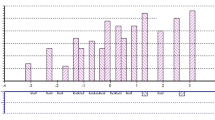Abstract
Background
Recently, an 8-item short-form version of the Chronic Pain Acceptance Questionnaire (CPAQ-8) was developed predominantly in an internet sample. Further investigation of the factor structure in a multidisciplinary pain clinic sample is required. Investigation of the concurrent validity of the CPAQ-8 after accounting for the effects of variables commonly measured in the pain clinic setting is also necessary.
Purpose
This study examines the factor structure and concurrent validity of the CPAQ-8 in a sample of treatment-seeking patients who attended a multidisciplinary pain clinic.
Methods
Participants were 334 patients who attended an Australian multidisciplinary pain service. Participants completed the CPAQ, a demographic questionnaire, and measures of patient adjustment and functioning.
Results
Confirmatory factor analysis identified a two-factor 8-item model consisting of Activity Engagement and Pain Willingness factors (SRMR = 0.039, RMSEA = 0.063, CFI = 0.973, TLI = 0.960) was superior to both the CPAQ and CPAQ with an item removed. The CPAQ and CPAQ-8 total scores were highly correlated (r = 0.93). After accounting for pain intensity, the CPAQ-8 was a significant predictor of depression, anxiety, stress, and disability. The subscales of the CPAQ-8 were both unique contributors to depression and disability in regression analyses, after accounting for pain intensity and kinesiophobia, and after accounting for pain intensity and catastrophizing.
Conclusions
The CPAQ-8 has a sound factor structure and similar psychometric properties to the CPAQ; it may have clinical utility as a measure of pain acceptance in treatment-seeking, chronic pain patients.
Similar content being viewed by others
References
McCracken LM, Vowles KE, Eccleston C. Acceptance of chronic pain: component analysis and a revised assessment method. Pain. 2004;197:159–66.
McCracken LM. Toward understanding acceptance and psychological flexibility in chronic pain. Pain. 2010;149:420–1.
Reneman M, Dijkstra A, Geertzen J, Dijkstra P. Psychometric properties of chronic pain acceptance questionnaires: a systematic review. European J Pain. 2010;14:457–65.
Nicholas MK, Asghari A. Investigating acceptance in adjustment to chronic pain: is acceptance broader than we thought? Pain. 2006;124:269–79.
Wicksell RK, Olsson GL, Melin L. The Chronic Pain Acceptance Questionnaire (CPAQ)—further validation including a confirmatory factor analysis and a comparison with the Tampa Scale of Kinesiophobia. European J Pain. 2009;13:760–8.
Geisser DS. A comparison of acceptance-focused and control-focused psychological treatments in a chronic pain treatment center (Unpublished Doctoral Dissertation). Reno, NV:University of Nevada; 1992
McCracken LM. Behavioral constituents of chronic pain acceptance: results from factor analysis of the chronic pain acceptance questionnaire. J Back Musculos Rehab. 1999;13:93–100.
Vowles KE, McCracken LM, McLeod C, Eccleston C. The Chronic Pain Acceptance Questionnaire: confirmatory factor analysis and identification of patient subgroups. Pain. 2008;140:284–91.
Fish R, McGuire B, Hogan M, Morrison T, Stewart I. Validation of the Chronic Pain Acceptance Questionnaire (CPAQ) in an Internet sample and development and preliminary validation of the CPAQ-8. Pain. 2010;149:435–43.
Vlaeyen JWS, Linton SJ. Fear-avoidance model of chronic musculoskeletal pain: 12 years on. Pain. 2012;153:1144–7.
Ferreira-Valente MA, Pais-Ribeiro JL, Jensen MP. Validity of four pain intensity scales. Pain. 2011;152:2399–404.
Flor H, Behle DJ, Birbaumer N. Assessment of pain-related cognitions in chronic pain patients. Behav Res Therapy. 1993;31:63–73.
Kori SH, Miller RP, Todd DD. Kinesiophobia: a new view of chronic pain behavior. Pain Management, 35–43, 1990.
Vlaeyen JWS, Kole-Snijders AMJ, Boeren RGB, van Eek H. Fear of movement/(re)injury in chronic low back pain and its relation to behavioral performance. Pain. 1995;62:363–72.
Rolland M, Morris S. A study of the natural history of back pain. Part I: development of a reliable and sensitive measure of disability in low-back pain. Spine. 1983;8:141–4.
Asghari A, Nicholas MK. Pain self-efficacy beliefs and pain behaviour. A prospective study. Pain. 2001;94:85–100.
Lovibond PF, Lovibond SH. The structure of negative emotional states: comparison of the depression anxiety stress scales (DASS) with the beck depression and anxiety inventories. Behav Res Therapy. 1995;33:335–43.
Nicholas MK, Asghari A, Blyth FM. What do the numbers mean? Normative data in chronic pain measures. Pain. 2008;134:158–73.
Taylor R, Lovibond PF, Nicolas MK, Cayley C, Wilson PH. The utility of somatic items in the assessment of depression in chronic pain patients: a comparison of the Zung Self-Rating Depression Scale (SDS) and the Depression Anxiety Stress Scale (DASS) in chronic pain and clinical and community samples. Clinical J Pain. 2005;21:91–100.
Browne MW, Cudeck R. Alternative Ways of Assessing Model Fit. In: Bollen KA, Long JSS, editors. Testing structural equation models. London: Sage; 1993.
Hu L, Bentler PM. Cutoff criteria for fit indexes in covariance structure analysis: conventional criteria versus new alternatives. Struct Equ Model. 1999;6:1–55.
DeCarlo LT. On the meaning and use of kurtosis. Psychol Methods. 1997;2:292–307.
McCracken LM. Learning to live with pain: acceptance of pain predicts adjustment in persons with chronic pain. Pain. 1998;74:21–7.
McCracken LM. Toward understanding acceptance and psychological flexibility in chronic pain. Pain. 2010;149:420–1.
DiStefano C, Motl RW. Further investigating method effects associated with negatively worded items on self-report surveys. Struct Equ Model. 2006;13:440–64.
Schmitt N, Stults DM. Factors defined by negatively keyed items: the result of careless respondents? Appl Psychol Measures. 1985;9:367–73.
Disclosures
No authors have any potential conflicts of interest. Preparation of this paper was supported in part by a National Health and Medical Research Council of Australia Career Development Fellowship held by Jason Connor (1031909).
Author information
Authors and Affiliations
Corresponding author
Rights and permissions
About this article
Cite this article
Baranoff, J., Hanrahan, S.J., Kapur, D. et al. Validation of the Chronic Pain Acceptance Questionnaire-8 in an Australian Pain Clinic Sample. Int.J. Behav. Med. 21, 177–185 (2014). https://doi.org/10.1007/s12529-012-9278-6
Published:
Issue Date:
DOI: https://doi.org/10.1007/s12529-012-9278-6




